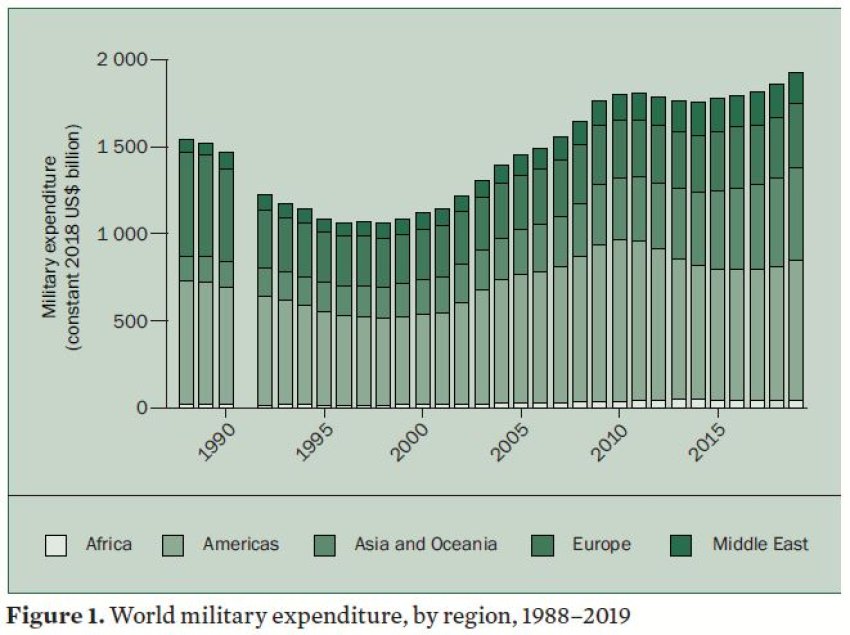
A new report has shown a sharp rise in global spending on arms and the military.
Total world military spending rose to US$1917 billion in 2019, according to new data from the Stockholm International Peace Research Institute (SIPRI). This represents an increase of 3.6% from 2018 and the largest annual growth in spending since 2010.
The graph shows a year on year increase since 1998 with the exception of three years after 2011, and the 2019 figure marks an acceleration in the recent trend of annual increases.
While military expenditure rose in at least four of five regions of the world (full figures are not available for the Middle East) there are a number of particularly important components to this surge.
One is increased arms spending under the Donald Trump government in the United States since it was elected in 2016. US arms spending grew by 5.3% to a total of $732 billion in 2019. The US remains by far the biggest military spender on the planet accounting for 38% of global military spending. To give some sense of its dominance, its increase in 2019 alone was equivalent to the whole of Germany’s military expenditure for that year. Despite Trump’s promises to end costly foreign wars he is responding to growing economic and geopolitical competition by re-arming.
The other most obvious trend is a steep increase in military spending in China and India. These two countries were, for the first time, respectively, the second and third-largest military spenders in the world. China’s military expenditure reached $261 billion in 2019, a 5.1% increase compared with 2018, and 85% higher than in 2010. Its military expenditure has increased continuously since 1994 and now amounts to 14% of global military expenditure.
China’s military spending is rising in lock step with the growth in its GDP. This is clearly a particularly important trend. If continued it will mean that China can become a more and more serious military competitor with the US in the Asia Pacific region where most of its firepower is concentrated, and, in the future potentially in other theatres. At $71.1 billion, India had the highest military spending in South Asia in 2019. It was 6.8% higher in 2019 than in 2018 but it has risen by 259% over the 30-year period 1990–2019. India’s tensions and rivalry with China and Pakistan are among the major drivers for its increased military spending.
The biggest regional increase was in Europe, where spending went up by 5% on 2018 and 8.8% on 2010. In Western Europe, this trend was led by Germany (10%) and France (1.6%). But what stands out is the increase in spending in Central and Eastern Europe: 14% and 4.9% respectively. All seven countries in Eastern Europe increased their military spending in 2019. Four countries in Central Europe, Lithuania, Latvia, Bulgaria and Romania, increased their military spending by more than 150%. Russia’s military expenditure went up by 4.5% from 2018 but it has been growing significantly over the past two decades. Last year it was 30% higher than in 2010 and 175% higher than in 2000.
The figures reveal a world in which arms spending is rising across most if not all regions. Militarily, the US is still overwhelmingly dominant, but as the report spells out, increased US military spending is itself the product of growing international tensions and increased concern about military competition.
The three key issues for the US and its allies are all reflected in the report. China is overwhelmingly the most serious challenge to US military hegemony and as recent US strategy documents make clear; it is perceived as the main threat. Secondly, whatever the exact details of last years’ expenditure, the two decades’ trend towards the militarisation of the Middle East looks set to continue and thirdly the sharp increases in arms spending by US allies in Eastern and Central Europe underline the extent to which tensions with Russia are growing.
Britain’s arms budget has not risen significantly in the past few years. But this background of growing international tensions is driving recent calls for a massive 50% increase in British arms spending. At a time of increased danger and faced with the catastrophe of coronavirus, we need to campaign against any increase and step up calls for a global ceasefire, the withdrawal of our troops from abroad and general disarmament.
The SIPRI report suggests that arms spending may decline in the next years as a result of the coronavirus crisis. This is far from inevitable. The coronavirus crisis has exacerbated tensions between the US and China, it is likely to generate more turbulence in the Middle East, and it is straining relations with Russia.
The crisis offers the opportunity for a strong argument for disarmament. Whether or not arms spending does actually fall depends partly on what the international movement does in the months ahead.
[Reprinted from Stop the War UK.]